Mnamon
Ancient writing systems in the Mediterranean
A critical guide to electronic resources
News
-
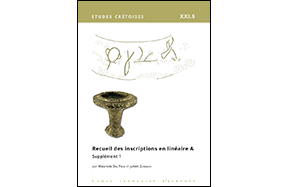 2025-05-21
2025-05-21Book
M. Del Freo et J. Zurbach, Recueil des inscriptions en linéaire A. Supplément 1, Études Crétoises 21.6, Athènes 2024, LXIV+256 pp. (ISBN 978-2-86958-642-0)
The Recueil des inscriptions en linéaire A is a seminal work, published in five volumes between 1976 and 1985 (Études Crétoises 21.1-5). These reference volumes compile all known Linear A inscriptions published up to 1985, offering a revised edition based on rigorous and consistent scholarly principles. The present supplement continues this tradition by incorporating Linear A texts discovered since 1985 and published up to 2023. The methodology employed closely follows that of J.-P. Olivier and L. Godart in the original five volumes of the Recueil, ensuring both continuity and scholarly coherence. This new contribution adds 107 documents and 427 signs to the corpus, bringing the total to 1,534 documents and 7,574 signs. The volume includes a section dedicated to dubious inscriptions (those whose attribution to Linear A remains uncertain) and concludes with a comprehensive sign index and a series of palaeographic tables.
More information here
(M.Del Freo) -
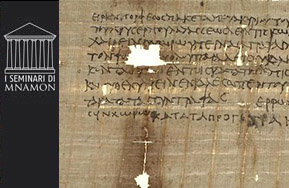 2025-05-06
2025-05-06Mnamon Seminars
On Tuesday May 27th at 11 a.m. the following seminar will be held in Aula Tonelli (Palazzo della Carovana) and online:
Lucia Criscuolo (Alma Mater Studiorum, Università di Bologna)
"Il piccolo dossier di Eirene: scritture, testi ed economia"
Abstract. Un piccolo gruppo di papiri conservati in due diverse collezioni americane contengono documenti relativi ad affari di una donna macedone vissuta tra il III ed il II secolo a.C. Le scritture, le modalità di stesura dei testi e il loro contenuto offrono la possibilità di ricostruire ed esaminare uno spaccato della società greca nell’Egitto lagide e di riflettere su alcuni suoi aspetti anche in prospettive rinnovate.
Live video streaming here.
(A.Russo) -
 2024-12-02
2024-12-02The origins of writing in ancient South-west Asia
A study conducted as part of the Inscribe (Invention of Scripts and their Beginnings) project of the Department of Classical Philology and Italianistics at the University of Bologna has led to the identification of correlations between a number of archaic cylindrical seal motifs dating back to the fourth millennium B.C.E. and a number of signs from protocuneiform, a writing system that predates cuneiform in the Mesopotamian region and to which the meaning associated with those motifs may have been transferred.
More information can be found in the article Kelley K., Cartolano M., Ferrara S.,Seals and signs: tracing the origins of writing in ancient South-west Asia, Antiquity, 2024
(S.Gaspa) -
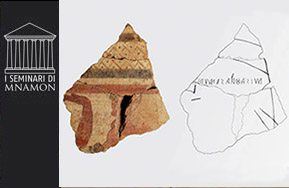 2024-11-04
2024-11-04Mnamon Seminars
On Friday November 8th at 4.30 p.m. the following seminar will be held online:
Daniele F. Maras (Direttore del Museo Archeologico Nazionale di Firenze)
"Firme invisibili etrusche e altre iscrizioni nascoste"
Abstract. Si presenta la scoperta recentissima di due firme “invisibili” di artista incise prima della cottura su terrecotte etrusche arcaiche, praticamente nascoste in piena vista nella decorazione di edifici sacri. La più antica è stata apposta sulla gamba di una delle figure divine sedute ad assemblea su una lastra a stampo ritrovata nel XVIII secolo nel santuario delle SS. Stimmate a Velletri: l’iscrizione è stata scoperta solo pochi anni fa, nonostante la terracotta, ben conservata, sia stata esposta per tre secoli alla vista di tutti. La seconda firma invece è incisa sopra la figura di un Sileno su una lastra dipinta da Cerveteri, ritrovata nel corso di uno scavo condotto dalla Soprintendenza nel 2018. Anche in questo caso l’iscrizione era sfuggita persino agli occhi dei restauratori, prima di essere finalmente riconosciuta.
Con l’occasione si approfondiranno il significato e il funzionamento di queste iscrizioni “invisibili”, con alcuni insospettabili confronti nell’ambito dell’epigrafia greca e con l’aiuto di fonti letterarie, che svelano l’uso inatteso di metodi crittografici e steganografici nell’antichità.
Live video streaming here.
(A.Russo) -
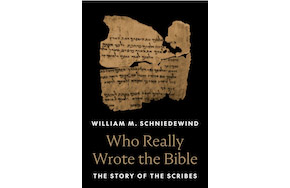 2024-09-25
2024-09-25Book
Who Really Wrote the Bible: The Story of the Scribes, by William M. Schniedewind, Princeton University Press, 2024
Who wrote the Bible? Its books have no bylines. Tradition long identified Moses as the author of the Pentateuch, with Ezra as editor. Ancient readers also suggested that David wrote the psalms and Solomon wrote Proverbs and Qohelet. Although the Hebrew Bible rarely speaks of its authors, people have been fascinated by the question of its authorship since ancient times. In Who Really Wrote the Bible, William Schniedewind offers a bold new answer: the Bible was not written by a single author, or by a series of single authors, but by communities of scribes. The Bible does not name its authors because authorship itself was an idea enshrined in a later era by the ancient Greeks. In the pre-Hellenistic world of ancient Near Eastern literature, books were produced, preserved, and passed on by scribal communities.
More information here.
(D. Tripaldi) -
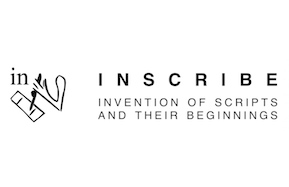 2024-09-03
2024-09-03Workshop
The workshop “INSCRIBE - at the Roots of Writing” will be held in Bologna and online from September 11th till 13th. A free registration is mandatory.
The conference will gather experts on the evolution of writing, early script invention, decipherment prospects, digital humanities & AI research applied to ancient scripts. It will take place over three days, each with a different theme: The Evolution and Invention of Writing The Decipherment of Ancient Scripts: State-of-the-Art Digital Humanities and AI applied to Ancient Scripts.
More information and the workshop program can be found here.
(A. Santoni) -
 2024-07-10
2024-07-10Isut
Isut is a tool for collaborative annotation and computational analysis of Hieratic texts, created by Mark-Jan Nederhof, Julius Tabin, and Christian Casey with the support of the University of Liège, which collects fully annotated Hieratic facsimiles of some well-known Egyptian texts. Its main purpose is to compare different shapes of Hieratic signs, distinguishing periods, provenances, and genres, which can be useful for dating and for identifying scribes.
The Guesser is a feature that allows the user to draw a Hieratic sign, and the tool will return the normalized hieroglyphs and Gardiner names of the shapes in the database that are most similar to it.
(D. Salvoldi) -
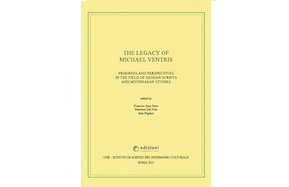 2024-05-13
2024-05-13Book
The Legacy of Michael Ventris: Progress and Perspectives in the Field of Aegean Scripts and Mycenaean Studies, edited by F. Aura Jorro, M. Del Freo, J. Piquero (Incunabula Graeca CVIII), Roma, CNR Edizioni, 2023, XVIII+350 pp.
The volume, published with the contribution of the Ministerio de Ciencia, Innovacion y Universidades (Spain), brings together 14 contributions on the impact that the decipherment of the Linear B script had on the study of the origins of Greek civilisation and is divided into three sections: one on Linear B and other Aegean scripts, one on Mycenaean Greek, and one on Mycenaean documents as historical sources. In the first section, some unresolved questions concerning the Aegean writing systems of the Bronze Age are discussed; in the second section, the Mycenaean Greek is analysed in the light of its phonetic, morphological, syntactic and lexical characteristics with particular reference to its relations with the Greek dialects of the 1st millennium BC; finally, the contributions in the third section focus on the significance of Linear B documents for the reconstruction of the social, religious and material history of Greece in the Late Bronze Age.
More information here.
(M. Del Freo) -
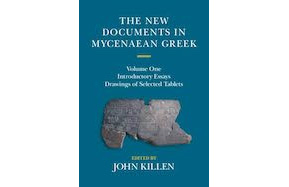 2024-02-20
2024-02-20Book
The New Documents in Mycenaean Greek, 2 vols., ed. by J. T. Killen, Cambridge, CUP, 2024, pp. xxviii (vol. 1) + xxvi (vol. 2) + 1145.
In 1952 Michael Ventris deciphered the script found on the Linear B tablets from Crete and the Greek mainland, therefore revealing the earliest known form of Greek. In 1956 he and John Chadwick published Documents in Mycenaean Greek, which gave an account of the decipherment, of the language of the tablets, of the society and economy revealed by the documents and a series of chapters giving texts, translations and commentary of the most important tablets. Though partially updated in 1973, Documents is now very much outdated: there has been a vast accrual of bibliography on the subject since 1973, and discoveries of tablets at new sites. This new survey, written by fourteen of the world's leading experts, will bring the reader fully up-to-date with developments in all aspects of Mycenaean studies, concluding with a new, full glossary of all the most recently discovered words.
(M. Del Freo) -
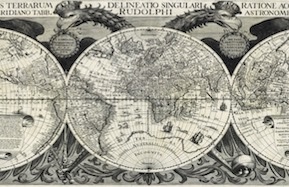 2024-02-19
2024-02-19Seminar
On Thursday February 22nd, starting at 10 a.m., the Seminar "Confini, terre di frontiera, limiti nel mondo antico e tardoantico" will be held within the PhD in Studi Storici. Storia e civiltà del mondo antico e del Vicino Oriente (Dipartimento di Storia, Archeologia, Geografia, Arte e Spettacolo. Storia, Archeologia, Geografia, Arte e Spettacolo. Dipartimento di Lettere e Filosofia) at the Sala Orbatello, via della Pergola 60 in Florence.
The Seminar is organized by G.A. Cecconi, A. Magnelli and G. Torri.
Poster with the seminar program
More information
(G.Torri)
